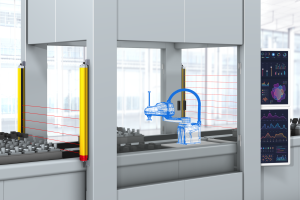 Future-focused manufacturers are edging closer to their ideals of flexible, efficient and sustainable production by exploring digital transformation in earnest. However, as interest in digitalisation builds, it is becoming apparent that a huge gulf exists between the worlds of OT (Operational Technology) and IT (Information Technology). This divide needs to be bridged if today’s visions for factories of the future are to become tomorrow’s reality.
Future-focused manufacturers are edging closer to their ideals of flexible, efficient and sustainable production by exploring digital transformation in earnest. However, as interest in digitalisation builds, it is becoming apparent that a huge gulf exists between the worlds of OT (Operational Technology) and IT (Information Technology). This divide needs to be bridged if today’s visions for factories of the future are to become tomorrow’s reality.
IT, OT and IoT are three similar acronyms that have very different meanings. In short, OT is focused on machine behaviour and outcomes, whereas IT relates to information and communication. OT covers those systems that interface with the real world, such as controls, actuators and sensors; IT covers the computer, data storage, networking infrastructure, software and processes that are used to produce all forms of electronic data. OT monitors events, processes and physical devices and generates information that is then processed by IT systems. IoT is the data flow between the two worlds – without data, there is no IoT.
From stand-alone solutions to eco-systems
Historically, OT and IT have existed as two distinct worlds, with companies specialised in one or the other. The simple reason for this is that no individual company can straddle both spheres. The problem with this siloed approach is that IT/OT connectivity is needed if both IT and OT are to be exploited to their full potential.
This realisation is driving the evolution of so-called ‘eco-systems’. Companies with different areas of expertise are coming together to form clusters that drive innovation on a higher plane and bring integrated IT/OT solutions to the marketplace.
One example of this synergistic approach is OMRON’s partnership with Dassault Systèmes. Dassault brings the IT element (virtual twinning) whilst OMRON brings OT (industrial automation). Together, these two companies form the core of an eco-system that can be adapted to different applications and markets by adding extended partners with specialist skills in areas such as wireless networking, system integration, robotics and machine building. The eco-system model provides a fast and flexible alternative to gaining in-house IT/OT capabilities via acquisition.

When real life meets virtual reality
Whilst this explains how IT/OT convergence can be achieved, it doesn’t explain why it is necessary. Here is an anecdote that illustrates the need for IT/OT connectivity: one of my two boys spends much of his spare time playing on a flight simulator. In the virtual world, his pilot skills are second to none, but I wouldn’t trust him to fly an actual plane because he has no real-world experience.
The same is true in the world of industrial automation. The IT provider might have the capabilities to create a virtual twin of a factory, a system or a production line, but what it lacks is real world knowledge of processes and equipment behaviour. Therefore, if a change is made in the virtual twin to optimise the process, the IT specialist does not know whether this is feasible in the real-life production environment. This is where the OT provider adds value – by giving data to the twin that will enable it to understand how the system will behave in real life. In this way, IT and OT work together, translating the insights gleaned from both worlds in a two-way street that leads to tangible improvements, whether accelerated time to market for a new product or more efficient use of labour and resources.
It’s important to emphasise that this is not the same as creating a one-time simulation of a process or a machine. The virtual twin mirrors the physical system in real time and can be run over the lifetime of a system or product, so there is always an opportunity to check – in a safe parallel digital environment – how new materials, new ingredients or new tools will behave. The continuous monitoring of the machine or process can also be channelled for preventative maintenance and energy management purposes.
IT/OT connectivity in action
 There are numerous examples of how IT/OT connectivity can bring benefits to industries such as e-mobility, pharmaceutical manufacturing and intralogistics. By creating a virtual model of a new machine or line, projects can be de-risked and the time it takes to build and test the installation can be dramatically reduced as costly mistakes are made in the virtual world. This is beneficial to any manufacturing industry, but in particular the automation industry, where there is huge pressure to accelerate time to market and minimise the risk of failure for new products.
There are numerous examples of how IT/OT connectivity can bring benefits to industries such as e-mobility, pharmaceutical manufacturing and intralogistics. By creating a virtual model of a new machine or line, projects can be de-risked and the time it takes to build and test the installation can be dramatically reduced as costly mistakes are made in the virtual world. This is beneficial to any manufacturing industry, but in particular the automation industry, where there is huge pressure to accelerate time to market and minimise the risk of failure for new products.
Another example of IT/OT convergence is where SCADA systems (IT) visualise what is happening on the production line through the capture of real-time data via connection to OT line elements. Edge control (OT) is then deployed to deliver fast feedback to the process, enabling immediate adjustments to be made.
Collaboration is key
Interactive, integrated, autonomous and intelligent automation solutions have the potential to transform manufacturing, but to deliver true value, these solutions need to seamlessly integrate IT and OT. Thankfully, the creation of eco-systems is making this happen, with exciting implications for designing flexible and future-proof production systems.

